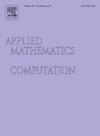Optimal information spreading strategy for containing epidemic spreading on higher-order multiplex networks
IF 3.4
2区 数学
Q1 MATHEMATICS, APPLIED
引用次数: 0
Abstract
When an epidemic spreads through a population, related information also spreads concurrently, prompting individuals to adopt protective behaviours (e.g., washing hands). Collective behaviour has been shown to play a critical role in shaping the dynamics of epidemic spreading, and higher-order networks offer a natural framework to describe such group interactions in social contact networks. Yet, the interplay between epidemic and information dynamics on higher-order structures is not fully understood, further limiting our understanding of the optimal information spreading strategy for containing epidemic spreading.In this study, we first construct a higher-order multiplex network framework based on simplicial complexes. Then, a coevolutionary spreading model is proposed, integrating epidemic spreading and information spreading on simplicial complexes. The epidemic spreads through both lower-order (pairwise) and higher-order (group) interactions, while information spreads through lower-order interactions in a degree-preferential manner. Using an extended Microscopic Markov Chain Approach, we analytically derive the dynamical equations of the system and compute the basic reproduction number using the next-generation matrix method. Finally, we conduct extensive numerical simulations of the spreading process across various parameter regimes. Our results demonstrate the role of higher-order infections in promoting epidemics. Although information spreading generally suppresses the spread of most epidemics, it can paradoxically enhance the spread of certain epidemics with a very low spreading capacity. Increases in the recovery probabilities of both the disease and the information can weaken the promoting effect of higher-order infection and enhance the suppressive effect of the information. For certain epidemics with weak spreading capabilities but strong recovery capabilities, the spread of information can completely suppress the outbreak of the disease, while the enhancement of higher-order infections can promote the outbreak of these diseases. By analysing the effects of different information spreading strategies on epidemic spreading, we find that the optimal strategy for containing the epidemic is to allow information to spread without degree preference.
高阶复用网络中控制疫情传播的最优信息传播策略
当流行病在人群中传播时,相关信息也同时传播,促使个人采取保护行为(例如洗手)。集体行为已被证明在形成流行病传播的动态方面发挥着关键作用,高阶网络为描述社会联系网络中的这种群体互动提供了一个自然框架。然而,疫情与信息动态在高阶结构上的相互作用尚不完全清楚,这进一步限制了我们对遏制疫情传播的最佳信息传播策略的理解。在本研究中,我们首先构造了一个基于简单复合体的高阶复用网络框架。在此基础上,提出了一种将疫情传播和信息传播结合在简单复合体上的协同进化传播模型。疫情通过低阶(成对)和高阶(群体)相互作用传播,而信息通过低阶相互作用以程度优先的方式传播。利用扩展的微观马尔可夫链方法,解析导出了系统的动力学方程,并利用新一代矩阵法计算了系统的基本再现数。最后,我们进行了广泛的数值模拟的扩散过程在不同的参数制度。我们的结果证明了高阶感染在促进流行病中的作用。虽然信息传播通常会抑制大多数流行病的传播,但矛盾的是,它可能会促进某些传播能力极低的流行病的传播。疾病和信息恢复概率的增加可以减弱高阶感染的促进作用,增强信息的抑制作用。对于某些传播能力较弱但恢复能力较强的流行病,信息的传播可以完全抑制疾病的爆发,而高阶感染的增强可以促进这些疾病的爆发。通过分析不同的信息传播策略对疫情传播的影响,我们发现控制疫情的最优策略是允许信息无程度偏好地传播。
本文章由计算机程序翻译,如有差异,请以英文原文为准。
求助全文
约1分钟内获得全文
求助全文
来源期刊
CiteScore
7.90
自引率
10.00%
发文量
755
审稿时长
36 days
期刊介绍:
Applied Mathematics and Computation addresses work at the interface between applied mathematics, numerical computation, and applications of systems – oriented ideas to the physical, biological, social, and behavioral sciences, and emphasizes papers of a computational nature focusing on new algorithms, their analysis and numerical results.
In addition to presenting research papers, Applied Mathematics and Computation publishes review articles and single–topics issues.

 求助内容:
求助内容: 应助结果提醒方式:
应助结果提醒方式:


